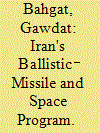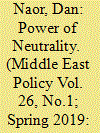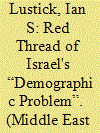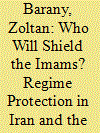|
|
|
Sort Order |
|
|
|
Items / Page
|
|
|
|
|
|
|
| Srl | Item |
| 1 |
ID:
167913


|
|
|
|
|
| Summary/Abstract |
In 2018, after the suppression of the Green Movement following the disputed presidential election of 2009, Iran witnessed another wave of uprisings. Despite temporarily disrupting the life of the state, Iran's 2018 protests were not successful in undermining the Islamic Republic. In the absence of any foreseeable fundamental change, observers of Iran agree on two premises regarding the future. First, reform from above and among the political elites is the safest, most stable way for the Islamic Republic to make the transition into a more normal and democratic regime. Second, this reform from above is impossible without the support of Supreme Leader Ayatollah Ali Khamenei, the strongest man in Iran's political structure.
|
|
|
|
|
|
|
|
|
|
|
|
|
|
|
|
| 2 |
ID:
167910


|
|
|
|
|
| Summary/Abstract |
Since the early 1970s, Iran has sought to develop strong missile capabilities. In recent years, Tehran's arsenal has evolved to become the largest and most diverse in the Middle East, though not the most lethal or longest‐range. Israel and Saudi Arabia have also developed formidable capabilities. Iran's program, however, has attracted more political and academic controversies. The Trump administration's decision to withdraw from the 2015 nuclear deal — the Joint Comprehensive Plan of Action (JCPOA) — was partly driven by the fact that it had failed to slow the progress of Iran's missile capabilities. The U.S. withdrawal and occasional European criticism of frequent missile testing have had little, if any, impact on Tehran's determination to advance its capabilities.
|
|
|
|
|
|
|
|
|
|
|
|
|
|
|
|
| 3 |
ID:
167912


|
|
|
|
|
| Summary/Abstract |
In December 2017, countrywide protests broke out in Iran in response to almost four decades of a brutal dictatorship that had presided over a deteriorating economy and an increasingly corrupt establishment. “Death to the Islamic Republic,” “Death to [Supreme Leader] Khamenei,” and “Death to [President] Rohani” were among the slogans that highlighted the crisis of legitimacy the regime is facing for its neglect of the people's misery. After the elections in May 2017, and most recently on January 22, 2018, in a live television interview, Rohani promised that, before the end of his second term in 2021, he would abolish absolute poverty1 in Iran. However, such promises are merely empty words. Forty years seems time enough to ameliorate poverty, the primary social concern among millions of Iranians, who have no expectation of any profound change. The severity of the situation can be seen, not only in the protests but also in the scholarly research and official and semi‐official media discussed below.
|
|
|
|
|
|
|
|
|
|
|
|
|
|
|
|
| 4 |
ID:
167917


|
|
|
|
|
| Summary/Abstract |
In 1943, on the eve of Lebanon's independence, the Maronite president, Bishara al‐Khuri, and the Sunni prime minister, Riad al‐Sulh, formulated the National Pact, which aimed to regulate political life and bridge the different aspirations of the Lebanese communities. The Pact stipulated that power would be shared on a communal basis. Another aspect of the Pact concerned Lebanese foreign policy. Here, too, the Pact attempted to mediate between the aspirations of the Christians and those of the Muslims. For their part, the Christians — especially the Maronites — aimed for separatism, independence from Lebanon's Arab surroundings, and attachment to the West. The Muslims, particularly the Sunnis, wished to connect with the Arab world, especially with Syria. Hence, the Pact stipulated that Lebanon should take the middle road, adhering neither to East nor West. In fact, the Pact dictated a kind of neutrality in foreign affairs, enabling Lebanon to act as a middle man, a connecting factor between opposing elements.
|
|
|
|
|
|
|
|
|
|
|
|
|
|
|
|
| 5 |
ID:
167918


|
|
|
|
|
| Summary/Abstract |
In the spring and early summer of 2018, Israeli forces shot or gassed more than 16,000 people. The ferocity of this response to the massing of Palestinians near the barrier surrounding the Gaza Strip is striking but not astonishing. It reflects a fundamental truth and springs from a deep fear. The truth is that the essential aspiration of the late nineteenth and early twentieth century architects of the Zionist movement was to ensure that somewhere in the world — and that place came to be Palestine — there would be a majority of Jews. The fear is of Jews losing the majority they achieved.
|
|
|
|
|
|
|
|
|
|
|
|
|
|
|
|
| 6 |
ID:
167916


|
|
|
|
|
| Summary/Abstract |
From Syria's independence in 1946 until the 1998 bilateral crisis, Turkish‐Syrian relations were characterized by hostility and mistrust. Not least in their uncooperative border interactions. In the 1950s, Turkey was concerned about the illegal transfer of goods across its Syrian border. In the 1980s and 1990s, preventing PKK (Kurdish Workers' Party) activities became Turkish policy makers' top security priority. Ankara even went so far as to plant landmines along the Syrian border.
|
|
|
|
|
|
|
|
|
|
|
|
|
|
|
|
| 7 |
ID:
167909


|
|
|
| 8 |
ID:
167915


|
|
|
|
|
| Summary/Abstract |
In March 2015, an assault in Tunis on the Bardo Museum by the Okba Ibn Nafaa Jihadi Brigade, affiliated with al‐Qaeda in the Islamic Maghreb (AQIM), led to the murder of 24 foreign tourists. In June of the same year, the city of Sousse was assaulted by ISIS, an attack in which 39 foreign tourists were killed. Worse, in March 2016, ISIS launched another strike, this time to take control of the border city of Ben Guerdane, known for its hostility to the central government in Tunis. This time, however, the Tunisian security services, supported by the local population, repelled the attack and inflicted heavy losses on ISIS. Three attacks, three events summarize the paradox of the trajectory of jihadi organizations in Tunisia.
|
|
|
|
|
|
|
|
|
|
|
|
|
|
|
|
| 9 |
ID:
167911


|
|
|
|
|
| Summary/Abstract |
The Iranian protest wave in the summer of 2018 and the ongoing sporadic strikes have been persistent reminders of the importance of regime protection. Since the establishment of the Islamic Republic in 1979, Iran has not been free of societal upheavals although they never posed a serious threat to the regime's survival. That they did not can be explained by the opposition's shortcomings and, more convincingly, the unhesitating and brutal crackdown of the regime's security forces. Still, not all parts of Iran's coercive apparatus are equally devoted to the imams' conservative rule. Under what conditions would military forces split from the government? What useful lessons can be drawn from Iran's own history and the examples of the Arab Spring upheavals?
|
|
|
|
|
|
|
|
|
|
|
|
|
|
|
|
| 10 |
ID:
167914


|
|
|
|
|
| Summary/Abstract |
There are 14 UN peace operations underway around the world, employing almost 100,000 soldiers, policemen and civilians at an annual cost of nearly $7 billion. Since it began its first peacekeeping efforts in 1948, the UN has launched over 70 such missions. Peacekeeping, and the wars it is supposed to help end, have evolved over that time. The earliest efforts concerned wars between countries over territory and were operations with straightforward goals. As peacekeeping became applied to civil wars, the objectives became complex and much more difficult. The most recent missions have had to deal with violent extremism, and that has made it impossible for the peacekeepers to succeed. The result is that peacekeeping today makes little contribution to peace and the peacekeepers have become ineffective and increasingly victims of the conflicts with which they have been asked to deal. To put it somewhat metaphorically, peacekeeping is a bandage and not a cure. It can help stop the bleeding, but it cannot heal the wound. To explain why that is the case requires tracing the changes in warfare and describing what the peacekeepers are asked to do as opposed to what they are capable of doing.
|
|
|
|
|
|
|
|
|
|
|
|
|
|
|
|
|
|
|
|
|